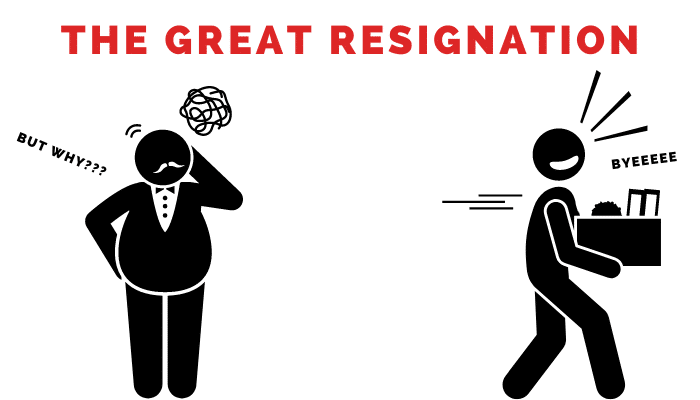The Great Resignation: Number of Workers are Quitting?

The Great Resignation, a concept invented by Texas A&M’s Anthony Klotz in 2019 to describe a huge, spontaneous departure out from workplace, has arrived, it is here to stay. The Great Resignation Simply means The Mass Resignation in other words.
Employees are resigning in massive numbers in the great resignation drive as when the world’s biggest economy continues on its Post-COVID path of recovery. That is indeed right. At a moment whenever commodities are suddenly attempting to profit from retaliatory expenditure and reduced demand, millions of employees over the globe are walking straight outside from respective positions, sometimes without a job in hand and no idea wherein their future chances lie.
But what is so behind such a ‘ The Great Resignation,’ that appears to have reached epidemic levels as unprecedented job postings appear with really no entrants?
What is Meant by The Great Resignation?

During the COVID-19 epidemic, the Great Resignation was an unofficial term describing the prevalent trend of a great number of people quitting their employment. The Big Quit is another name for it. The Great Resignation is usually considered in terms of the American workforce, but it is a global phenomena.
How Many Workers Have Left Their Jobs During “The Great Resignation”?
According to the US Labor Department, more than 34 million Americans have departed their jobs this year, but the trend appears to be have gained up some speed following April – right about the time the business starting to reopen up perfectly. Since that time, more than 24 million employees have left their jobs.
If something, the number of persons resigning has increased. According to the most recent figures from a US Department Of labour, 4.4 million workers departed their professions in September, up from 4.3 million in August. In September, there have been 10.4 million job opportunities, down from 10.6 million in August.
Read Also-What Is a VPN? – Virtual Private Network
According to estimates, the number of unemployed workers has topped 10 million for four months each time — the pre-pandemic maximum was 7.5 million — when there were more job postings in September than the 7.7 million jobless. As the holiday season comes, this emphasizes the recruiting difficulties that firms throughout the United States are facing. Interestingly, there really are about 5 million low – income people who want to work.
Several countries, such as Canada and the United Kingdom, have seen similar patterns. In July, and over a third of European companies reported worker difficulties, the biggest level in three years. However, while job turnover in the United States is notable, the Great Resignation is projected to have a global influence.
Microsoft released the findings of a survey in March of this year, stating that 41% of “the worldwide workforce is inclined to question quitting their current company relatively soon, with 46% expecting to make a massive turnaround or professional transfer.”

Which Sectors Have Seen the Biggest Departures During “The Great Resignation”?
In the United States, the hotel and retailing industries have had the greatest leave rates in the great resignation drive. According to recent statistics, the majority of these positions — in cafes, resorts, supermarkets, manufacturing, and other such establishments — require individuals to work very closely quarters.
A prior survey conducted by the Harvard Review (HBR) indicated that the number of people quitting increased in the healthcare and IT sectors over through the previous year, but “resignations declined significantly somewhat in businesses such as industrial and banking.”
“Resignation percentages were greater amongst people that worked in industries that already had witnessed dramatic spikes in demand owing to the epidemic, possibly addition to greater burdens and exhaustion,” according to the Harvard Business Review analysis.
Read Also-What Is 3D Animation ? – IGW – Infographic World
According to US Labor Department figures, the ‘quit rate’ in the recreation and hospitality industry peaked at 6.4 percent in September, upwards of about double overall average of 3%. The dropout percentage in arts, entertainment, and recreation — which is considered a component of recreation and hospitality — increased to 5.7 percent from 3.2 percent.
Industries With Highest Percentages of Workers Quitting During “The Great Resignation”?
In September 2021, the number of people who resigned their jobs reached a new high of 4.4 million.
| Leisure and Hospitality | 6.4% |
| Trade, Transportation and Utilities | 3.6% |
| Professionals and Business Services | 3.3% |
| Other Services | 3.1% |
| Education and Health Services | 2.8% |
| Manufacturing | 2.7% |
| Construction | 2.5% |
| Mining and Logging | 1.5% |
| Information | 1.5% |
| Financial Activities | 1.5% |
| Government | 1% |
What Are The Reasons Driving People To Walk Out On Their Jobs?
According to estimates, employees are resigning in droves in order to progress into further profitable roles or improved workplace conditions, even though corporations battle to fill positions available before about what is likely to be a busy festive period.
Others, on the other hand, have resigned and therefore are not seeking for a new job, at least not right away. This group includes women being unable to locate or pay child care, as well as adults who are not ready to come back to employment that require them to work very closely proximity toward others.
Then there are those Americans who’ve already worked and saved their incentive payments from the outbreak and now have something more to ultimately depend forward as they re-evaluate their career and life choices. According to the results of a worldwide study done previously this year by accountants EY, 54% of participants said that they would think about leaving their job once the epidemic has passed if they are not given some type of flexibility as to where and then when they operate.
According to Microsoft’s research, ‘The Very next Great Revolution Is Blended Effort Humans Fully prepared?,’ the shift to working remotely seems to have a lot to do about people choosing to leave in one manner or another. The majority of the workers will indeed tend to favor a hybrid approach of jobs in the future, according to the report.
Because working remotely “has invented employment opportunities among some, decided to offer so much time with the family, and supplied possibilities for who or what or whether to take public transit,” even though “virtual tiredness is a genuine and untenable potential danger” due to continuing to work in storage facilities during the great resignation drive.
So, Who Are Quitting During “The Great Resignation”?
According to the HBR analysis, immediate post human requirements of jobs 30 to 45 years had the largest proportion of resignations during the great resignation, while younger employees, who are often viewed as one of the most flexible labor markets employees, had the lowest rate. Owing to a “combined effect of their larger economic instability and less desire for admittance employees,” employees in the 20 to 25 age range may well have liked to keep their positions, according to the survey.
According to HBR, departure levels for employees in the 60 to 70 age group declined, but those in the 25-30 and 45+ age groups had greater rates than in 2020.
According to HBR, the greatest attrition rate among mid-level employees may be due to firms’ inclination for attracting employees who won’t also have to be trained for new tasks right away, and employing employees with just some amount of expertise is the best approach to keep operations going as cleanly as expected.
However, the paper also points out that several workers’ decisions to leave were likely influenced by fatigue and heavy pressure of work, as well as salary cuts and despondency resulting from a dearth of development potential during in the epidemic.
Individuals are looking for decent quality professions that guarantee greater balance among work and personal development and bring satisfaction in the tasks provided, according to mental health providers and business observers.
Experts predict employees to gradually return as industries recover post-COVID, though a Goldman Sachs analysis predicts that companies will still be operating with a substantially smaller staff now than it was before outbreak, implying that economic troubles will persist for months and even years.
What’s Happening In The Indian Jobs Space Due to “The Great Resignation”??
Employee walkouts in India have not reached the epidemic levels observed abroad, but analysts note out that even the employment market and social welfare system in India are not similar to those in developed countries.
During the epidemic in India, unorganized sector employees took a blow, and millions of people are thought to have deserted city occupations to return to their villages in the hinterlands. According to a source, up to 80% of informal laborer’s quit their jobs during in the lockdown.
However, when the economy gets better, the nation is expected to witness a strong job rebound. According to estimates, job opportunities are significantly more this year than they were last year at this time. Companies are expanding recruiting to develop capacity in the tech industry, which is causing a flurry of activity. As a result, turnover is at an all-time high.
According to Team Lease, the IT industry will experience a high turnover rate of around 22-23 percent in 2021, with over 1 million job cuts projected.
Read More: The Great Resignation: The Number Of Job Dropouts Continues To Rise, With Top IT Companies Worried
Conclusion
While the causes of the Great Resignation are numerous, they are mainly slight variations. As shown in a LinkedIn survey, 74 percent of the respondents said that spending time with the family during in the epidemic — whether during shut-downs or working from home — forced them to reconsider their present employment status.
Many people identify stressful situations in their present workplace as a motivation for seeking for work somewhere, with over half citing this as a reason in multiple surveys. Some cite displeasure, if not outright terror, created by their present client’s lower extremity expense initiatives in reaction to Covid-19-related economic shutdowns as a motivation for leaving, with many seeing basic injustice in the situation.






